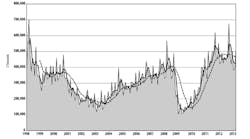U.S. manufacturers’ new orders of machine tools and related technology rose over 30% during March, the second month in a row indicating rising demand, and also gained an edge over the March 2012 result. The results are contained in the monthly U.S. Manufacturing Technology Orders report, compiled by AMT – The Association for Manufacturing Technology, and based on actual data for domestic and imported products ordered by U.S. machine shops and other manufacturers.
The March new orders totaled $507.91 million, an increase of 30.4% over the revised result for February, $389.37 million. The new result represents $468.09 million in metal cutting equipment and technology, and $39.83 million in orders for metal forming and fabricating products.
The March result is also 3.24% higher than the $491.96 million on record for March 2012, another period of rising demand.
“When making a year-over-year comparison with these figures, it’s important to take into account just how strong 2012 was for our industry. Our members are doing much better than analysts projected in January,” stated AMT president Douglas K. Woods.
2012 started out with indications of strong demand, but orders slowed in the second quarter of last year. An outstanding result for September 2012 helped push the annual total to a positive result.
For the current year to-date, domestic manufacturers have ordered $1,278.05 million of products and equipment, according to the USMTO report. This represents a -5.0% decline versus the three-month total for 2012. The negative result indicates the weak demand that prevailed in the early weeks of 2013.
“With vehicle sales and housing starts on the upswing, we can anticipate that gains in the consumer economy will also mean buoyancy for the industrial economy, and manufacturing will remain steady for the foreseeable future,” Woods continued in his statement.



